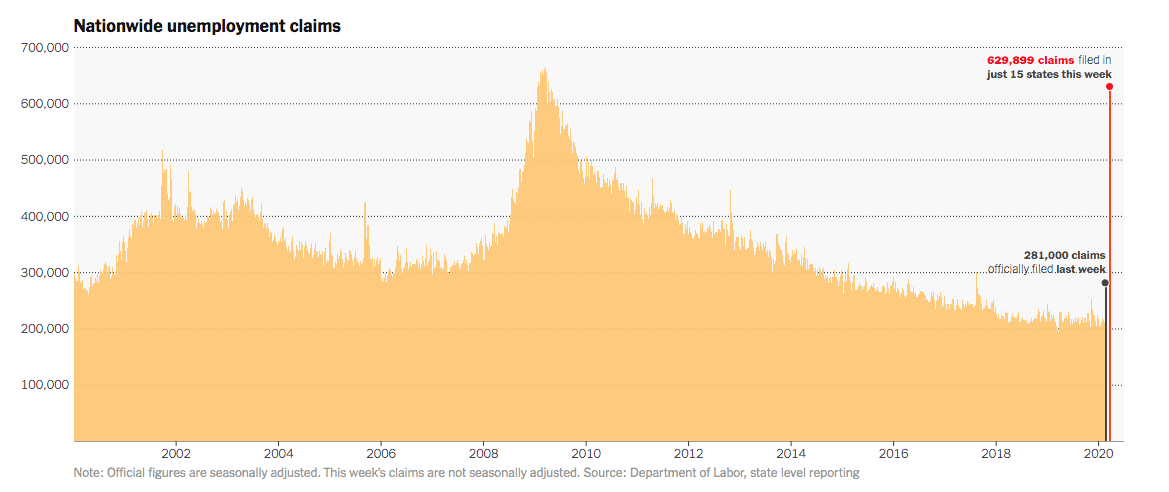Hi, everyone. It’s hard to believe just two weeks ago we were going about our daily lives, and even as I was writing this newsletter last week, I had just returned from a visit to Haywood Community College — my last school visit for the foreseeable future. Our world as we know it is rapidly changing.
I’ve been thinking about the best use of this newsletter. On the one hand, I want to help you wade through all the news coming out daily (or hourly) on the virus and the interesting policy solutions that are emerging. On the other hand, you probably need a break from COVID-19 at times.
So, I’m going to try out a new format. I’ll provide a brief summary of the most recent COVID-19 news that I think would be helpful for you to know. Then, each week I’ll take a look at one policy challenge arising from the pandemic and how policymakers are dealing with it. I’ll try to incorporate as much non-virus content as I can, provided people are still writing about non-virus subjects.
Feel free to reply to this email and give your feedback. Do you like this format? Want more COVID-19 news? Want less? What questions do you have? Let me know by replying here or emailing [email protected].
Stay safe and healthy!
Need to know: COVID-19
- As of 9:35 a.m. Friday, March 20, there were 137 confirmed cases in North Carolina.
- NCDHHS has expanded the criteria to get tested. If you meet the criteria, call your doctor or local health department. Additionally, LabCorp announced it can perform more than 20,000 tests a day beginning today, March 20.
- All K-12 NC public schools closed Monday for at least two weeks, though it will likely be much longer. Both the UNC System and the NC Community College System have advised colleges to move instruction online wherever possible.
- President Trump and the U.S. Department of Education announced schools can cancel their federally required standardized tests this year.
- Find all school meals available in each district here.
- Tax Day has been moved from April 15 to July 15.
For more, EdNC is updating this article daily with news and resources. All daily updates are archived at the bottom of the post, providing a record of what’s happened over the past two weeks.
Policy challenge: Historic rise in unemployment
The U.S. Department of Labor reported a sharp uptick in unemployment claims last week: 281,000 up from 211,000 the week before. Yesterday, the Upshot reported 629,899 claims filed in just 15 states this week, and Goldman Sachs economists predicted we will see between 1 to 2.25 million Americans file claims this week.

This Washington Post article illustrates the challenges faced by workers who have been either laid off, furloughed, or have had their hours dramatically reduced. Many states have restrictions on unemployment benefits that mean workers who need it currently do not qualify.
To address this in North Carolina, Gov. Cooper announced an executive order on Tuesday to:
- Remove the one-week waiting period to apply
- Remove the requirement that a person must be actively looking for another job
- Allow people who have had their hours reduced to apply
- Allow people to apply by phone or online versus in person
- Direct that employers will not be held responsible for benefits paid as a result of COVID-19 claims
At the federal level, Congress and the White House are both working on economic stimulus packages that include giving cash directly to Americans, relief for impacted industries, and small business loans. See the featured read from Brookings Institute below about the variety of responses popping up across country.
What we're reading
Cities and states are on the front lines of the economic battle against COVID-19
A look at what cities and states across the country are doing to provide assistance to workers and small businesses. ... Read the rest-
Can computers ever replace the classroom?
-
A country diner and its biscuits provide a reprieve from coronavirus in small-town NC
-
Why Singapore’s coronavirus response worked – and what we can all learn
-
Podcast | Introducing ‘Hope Starts Here’
-
Time to Activate this Decade-Old Food Aid Program
-
The Art of Socializing During a Quarantine


